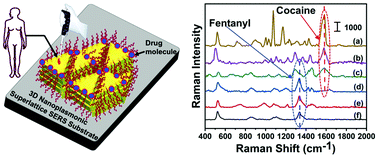Optimization of electromagnetic hot spots in surface-enhanced Raman scattering substrates for an ultrasensitive drug assay of emergency department patients’ plasma†
Abstract
Herein we report the programmable preparation of ultrasensitive surface-enhanced Raman scattering (SERS)-based nanoplasmonic superlattice substrates to assay fentanyl and cocaine (detection and quantification) from 10 μL aliquots of emergency department patient plasma without the need for purification steps. Highly homogeneous three-dimensional (3D) nanoplasmonic superlattices are generated through the droplet evaporation-based self-assembly process of chemically-synthesized, polyethylene glycol thiolate-coated gold triangular nanoprisms (Au TNPs). Close-packed, solid-state 3D superlattice substrates produce electromagnetic hot spots due to near-field plasmonic coupling of Au TNPs, which display unique localized surface plasmonic resonance properties. These uniquely prepared superlattice substrates enable strong SERS enhancement to achieve a parts-per-quadrillion limit of detection using the label-free SERS-based technique. Our reported limit of detection is at least 100-fold better than any known SERS substrates for the drug assay. Importantly, our density functional theory calculations show that a specific electronic interaction between the drug molecule and novel nanoplasmonic superlattice substrates plays a critical role that may trigger achieving this unprecedentedly high sensitivity. Additionally, we show high selectivity of the superlattice substrate in the SERS-based detection of analytes from different patient samples, which do and do not contain target analytes (i.e., fentanyl and/or cocaine). The demonstrated sensitivity and selectivity of 3D superlattice substrates for SERS-based drug analysis in real toxicological samples are expected to advance the field of measurement science, and forensic and clinical toxicology by obviating the need for complicated sample processing steps, long assay times, and the low sensitivity of existing “gold standard” analytical techniques including gas chromatography/mass spectrometry, liquid chromatography/mass spectrometry and enzyme-linked immunosorbent assays. Taken together, we believe that this entirely new and reproducible superlattice substrate for the SERS analysis will aid scientific, forensic, and healthcare communities to battle the drug overdose epidemic in the United States.



 Please wait while we load your content...
Please wait while we load your content...